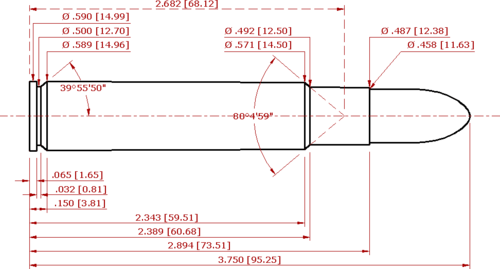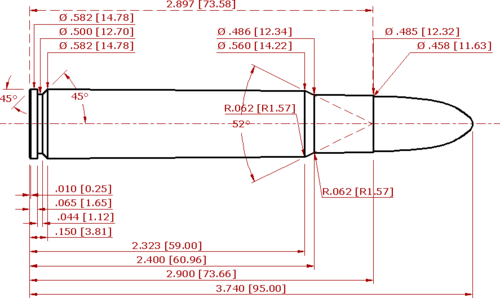.450 Rigby
| .450 Rigby Rimless | ||||||||
|---|---|---|---|---|---|---|---|---|
| Type | Rifle | |||||||
| Place of origin |
| |||||||
| Production history | ||||||||
| Designer | Paul Roberts | |||||||
| Designed | 1994 | |||||||
| Manufacturer | John Rigby & Co. | |||||||
| Produced | 1995 | |||||||
| Variants | .450 Dakota | |||||||
| Specifications | ||||||||
| Parent case | .416 Rigby Rimless | |||||||
| Case type | Rimless bottlenecked | |||||||
| Bullet diameter | .458 in (11.6 mm) | |||||||
| Neck diameter | .487 in (12.4 mm) | |||||||
| Shoulder diameter | .571 in (14.5 mm) | |||||||
| Base diameter | .589 in (15.0 mm) | |||||||
| Rim diameter | .590 in (15.0 mm) | |||||||
| Rim thickness | .065 in (1.7 mm) | |||||||
| Case length | 2.894 in (73.5 mm) | |||||||
| Overall length | 3.750 in (95.3 mm) | |||||||
| Case capacity | 136 gr H2O (8.8 cm3) | |||||||
| Primer type | Large rifle (magnum) | |||||||
| Maximum pressure | 58,000 psi (400 MPa) | |||||||
| Ballistic performance | ||||||||
| ||||||||
|
Test barrel length: 26 Source(s): Kynoch/Kynamco | ||||||||
The .450 Rigby Magnum Rimless, better known simply as the .450 Rigby, is a .45 caliber (11.6 mm) rimless, bottlenecked cartridge intended for the hunting of heavy dangerous game. The cartridge is based on the .416 Rigby necked up to accept a .458-inch (11.6 mm) bullet. The cartridge is intended for use in magazine rifles.[1] The cartridge should not be confused with the .450 Rigby Nitro Express, which is a rimmed cartridge that is intended for double rifles.
History
In 1993 Paul Roberts (at the time proprietor of John Rigby & Company) was on an elephant hunt in the Zambezi Valley. Both he and his professional hunter, Joseph Wright, were armed with .416 Rigby rifles for the occasion. An elephant was found and then shot in the lungs, but due to a misjudgment in distance several more rounds were required to finally bring down the elephant.[2]
After this experience, Paul Roberts felt that a cartridge with a greater bullet weight of a larger caliber would have been more effective in that situation. Once Paul Roberts returned to the United Kingdom he necked up the .416 Rigby case to .458 caliber. The new cartridge fired the 480-grain (31 g) of the .450 Nitro Express cartridge at a velocity of 2,378 ft/s (725 m/s) from a 25.5-inch (650 mm) barrel. The new cartridge was named the .450 Rigby Magnum Rimless in 1994.[2] The cartridge was put into production in 1995. The John Rigby & Company was building the .416 Rigby rifles on the 98 Magnum Mauser action. Since the .416 Rigby and the .450 Rigby use basically the same case, building rifles for the .450 Rigby was rather simple requiring only a chamber with a modification made in the collar area and a .458 caliber (11.43 mm) barrel.
Cartridge Specifications
The .416 Rigby which was designed by the John Rigby & Co. in 1911 was one of the most voluminous cartridge cases designed for magazine rifles. By today’s standards it is a rather inefficient cartridge when burning smokeless powder to achieve the desired velocity with a given bullet weight. This is due to the large capacity case which was designed for use with cordite rather than smokeless powder. Consequently, the .450 Rigby, which uses virtually the same case as the .416 Rigby in turn suffers the same inefficiencies. The .458 Lott will use about 81.0 gr (5.25 g) of a powder to reach 2,350 ft/s (720 m/s) with a 500 gr (32 g) bullet while the .450 Rigby will use about 99.0 gr (6.42 g) to reach the same velocity with the same bullet. This works out to be about 22% more powder for equal velocity with the same bullet weight. This is due to the larger capacity of the .450 Rigby case which has a case capacity of 133.1 gr. of water (8.64 cm3). However, since the case is voluminous, it is able to turn out this performance at lower pressure levels which is considered beneficial and adding a greater safety margin in a dangerous game rifle cartridge intended for use in the tropics.
The .450 Rigby dimensions and specifications are standardized and governed by the CIP.

- CIP compliant .450 Rigby Magnum Rimless cartridge schematic: All dimensions in inches [millimeters].
The CIP recommends a bore diameter of 11.43-millimetre (0.450 in) and a groove diameter of 11.63-millimetre (0.458 in). Barrel will have a 6 grove rifling contour with a twist rate of one revolution in 420 mm (17 in) and a groove width of 3.60-millimetre (0.142 in). CIP specifies a maximum pressure of 4,000 bar (58,000 psi).
Performance
Unlike many of the modern .458 caliber dangerous game cartridges like the .458 Winchester, .458 Lott or the .460 Weatherby Magnum, the .450 Rigby was designed to operate at more moderate pressures. Maximum pressure limits enforced by CIP is given at 4,000 bar (58,000 psi). At these pressures, the cartridge easily reaches the intended 2,300–2,400 ft/s (700–730 m/s) with the 500-grain (32 g) bullet.[2] The lower pressures provide greater operational reliability in tropical environments where the cartridge is intended for use. Heat can cause higher than normal pressures which can lead to difficulty in extracting the spent case. In a dangerous game hunting situation such failures can result in injury or possibly a fatality.
Unlike the .458 Winchester Magnum and to a degree the .458 Lott, the .450 Rigby reaches the coveted 2,400 ft/s (730 m/s) velocity mark with the 500 gr (32 g) with ease and well under the pressure limits imposed by the CIP upon the cartridge. Handloaders can take advantage of the wide range of .458 caliber (11.6 mm) bullets available. Acceptable bullets weight range from 300-grain (19 g) to 600-grain (39 g). The 500-grain (32 g) bullet can easily reach 2,500 ft/s (760 m/s) and staying within the pressure limitation imposed on the cartridge.[3]
Among commercial sporting cartridges, only the .460 Weatherby Magnum offers a superior performance over the .450 Rigby. However, most bullets manufactured such as those by Hornady and Woodleigh are rated for .450 Rigby velocities rather than those achievable through the .460 Weatherby. For this reason actual performance and penetration on heavy thick skinned game species are on par between these two cartridges. The Weatherby cartridge has a 6% greater capacity than the .450 Rigby but operates at higher pressures.
Sporting Use
The .450 Rigby was designed primarily to take heavy, thick skinned, dangerous game species. Due to the cartridge’s performance, it would be considered a better cartridge for these game species such as African elephant, Cape buffalo, rhinoceros and perhaps hippopotamus than the usual standby cartridges used on these game such as the .458 Winchester Magnum or even the .458 Lott cartridges especially if one was to use handloaded ammunition. When hunting these game species a bullet of a tough construction is required especially at the velocities the .450 Rigby is capable of attaining. It is important to tailor the performance to the velocity rating of the bullet with regard to this cartridge as it provides a step up in performance over the cartridges the .458 caliber (11.43 mm) bullets are manufactured for. This is especially true for soft-nosed bullets as they can open up too rapidly at velocities the .450 Rigby can attain. When hunting these game species only bullets weighting 450–600 gr (29–39 g) of a tougher construction should be used.
For lighter game species and other non-dangerous plains game bullets weighing as little as 250 gr (16 g) are available for handloading. The lightest of these bullets are manufactured for cartridges such as the .45-70 Government and the .450 Marlin; these bullets may not be best suited for use with the .450 Rigby. Loaded correctly, the .450 Rigby will hit harder and shoot flatter than most big bore cartridge making a good plains game rifle, albeit more powerful a cartridge than necessary for plains game. While the .450 Rigby is too powerful for use against North American game, it is conceivable that the cartridge would provide a powerful stopper against polar and Alaskan brown bear and is equally suited for the harvesting of the American bison.
.450 Dakota
The .450 Dakota is a variation on the design of the .450 Rigby but predates the latter cartridge by a few years. The Dakota cartridge was designed by Don Allen and is like the .450 Rigby based on the .416 Rigby case necked up to accept a .458 caliber (11.43 mm) bullet. The .450 Dakota is considered a proprietary cartridge, the rights to which are owned by Dakota Arms Inc., Remington Arms Company and the Freedom Group family of companies. Neither the CIP nor SAAMI regulate nor have oversight over this cartridge. While dimensions of the cartridges are similar they are not identical and are not interchangeable due to the shoulder dimensions and the case length. The performance of both cartridges are almost identical. However, Dakota Arms' ammunition is loaded closer to 65,000 psi (4,500 bar).

- Schematic of the .450 Dakota. All dimensions in inches [millimeters].
The .450 Dakota launches a 500 gr (32 g) at 2,550 ft/s (780 m/s), a 550 gr (36 g) at 2,450 ft/s (750 m/s) and the 600 gr (39 g) at 2,350 ft/s (720 m/s). While these velocity values are greater than that of the .450 Rigby cartridge, the Dakota ammunition is loaded to near maximum pressure levels while the .450 Rigby is loaded to a pressure level far below the 4,000 bar (58,000 psi) stipulated by the CIP. Given equal pressure level the .450 Rigby will turn out a similar performance level as the .450 Dakota cartridge; this is evident through third-party reloading data provided for the .450 Rigby. Any differences between these cartridges are strictly due to the components use and the pressure level than due to an actual difference between the cartridges.
References
- ↑ Barnes, Frank C. (2006) [1965]. Skinner, Stan, ed. Cartridges of the World (11th ed.). Gun Digest Books. p. 399. ISBN 0-89689-297-2.
- 1 2 3 Haley, Charlie. "The .450 Rigby Magnum Rimless:-A Look At the Cartridge and a Rifle" (PDF). African Hunter (Harare, Zimbabwe: Mag-Set Publications) 11 (1): 45–48. Retrieved 28 September 2010.
- ↑ Stumpfe, Karl (July 2004). "Reloading the .450 Rigby Rimless Magnum" (PDF). man Magnum (South Africa: South African Man Pty Ltd): 80–83. Retrieved 29 September 2010.